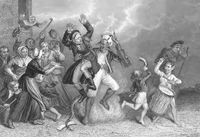Annotation:Devil or No Devil: Difference between revisions
No edit summary |
m Text replacement - "garamond, serif" to "sans-serif" |
||
| (One intermediate revision by one other user not shown) | |||
| Line 1: | Line 1: | ||
'''Back to [[{{BASEPAGENAME}}]]''' | '''Back to [[{{BASEPAGENAME}}]]''' | ||
---- | ---- | ||
<p><font face=" | <p><font face="sans-serif" size="4"> | ||
'''DEVIL OR NO DEVIL'''. AKA - "Devil and no Devil." English, Jig. G Major. Standard tuning (fiddle). AABB. The melody first appears in J. Wilson's '''The Pocket Preceptor for the Fife''' (London, 1805), followed by '''J. Hewitt's Fashionable Repertory of Country Dances and Waltzes''' (New York, 1807-1810, with an alternate title of "[[Devil in Ireland]]"). It later appeared in dancing master Thomas Wilson's '''Companion to the Ball Room''' (London, 1816). American musician Abel Shattuck (1759-1816, Colrain, Mass.) entered it into his music manuscript copybook, which he began around 1801. | '''DEVIL OR NO DEVIL'''. AKA - "Devil and no Devil." English, Jig. G Major. Standard tuning (fiddle). AABB. The melody first appears in J. Wilson's '''The Pocket Preceptor for the Fife''' (London, 1805), followed by '''J. Hewitt's Fashionable Repertory of Country Dances and Waltzes''' (New York, 1807-1810, with an alternate title of "[[Devil in Ireland]]"). It later appeared in dancing master Thomas Wilson's '''Companion to the Ball Room''' (London, 1816). American musician Abel Shattuck (1759-1816, Colrain, Mass.) entered it into his music manuscript copybook, which he began around 1801. | ||
[[File:devil.jpg|200px|thumb|left|The Devil takes the fiddler.]] | |||
<br> | <br> | ||
<br> | <br> | ||
| Line 9: | Line 10: | ||
<br> | <br> | ||
</font></p> | </font></p> | ||
<p><font face=" | <p><font face="sans-serif" size="4"> | ||
''Source for notated version'': | ''Source for notated version'': | ||
<br> | <br> | ||
<br> | <br> | ||
</font></p> | </font></p> | ||
<p><font face=" | <p><font face="sans-serif" size="4"> | ||
''Printed sources'': Kennedy ('''Jigs & Quicksteps, Trips & Humours'''), 1997; No. 26, p. 8. Wilson ('''Companion to the Ball Room'''), 1816; p. 126. | ''Printed sources'': Kennedy ('''Jigs & Quicksteps, Trips & Humours'''), 1997; No. 26, p. 8. Wilson ('''Companion to the Ball Room'''), 1816; p. 126. | ||
| Line 20: | Line 21: | ||
<br> | <br> | ||
</font></p> | </font></p> | ||
<p><font face=" | <p><font face="sans-serif" size="4"> | ||
''Recorded sources'': <font color=teal></font> | ''Recorded sources'': <font color=teal></font> | ||
</font></p> | </font></p> | ||
Latest revision as of 12:14, 6 May 2019
Back to Devil or No Devil
DEVIL OR NO DEVIL. AKA - "Devil and no Devil." English, Jig. G Major. Standard tuning (fiddle). AABB. The melody first appears in J. Wilson's The Pocket Preceptor for the Fife (London, 1805), followed by J. Hewitt's Fashionable Repertory of Country Dances and Waltzes (New York, 1807-1810, with an alternate title of "Devil in Ireland"). It later appeared in dancing master Thomas Wilson's Companion to the Ball Room (London, 1816). American musician Abel Shattuck (1759-1816, Colrain, Mass.) entered it into his music manuscript copybook, which he began around 1801.

A different, duple-time, tune of the same name was printed by John and Michael Paff in their Four New Country Dances in New York in 1799.
Source for notated version:
Printed sources: Kennedy (Jigs & Quicksteps, Trips & Humours), 1997; No. 26, p. 8. Wilson (Companion to the Ball Room), 1816; p. 126.
Recorded sources:
Back to Devil or No Devil
